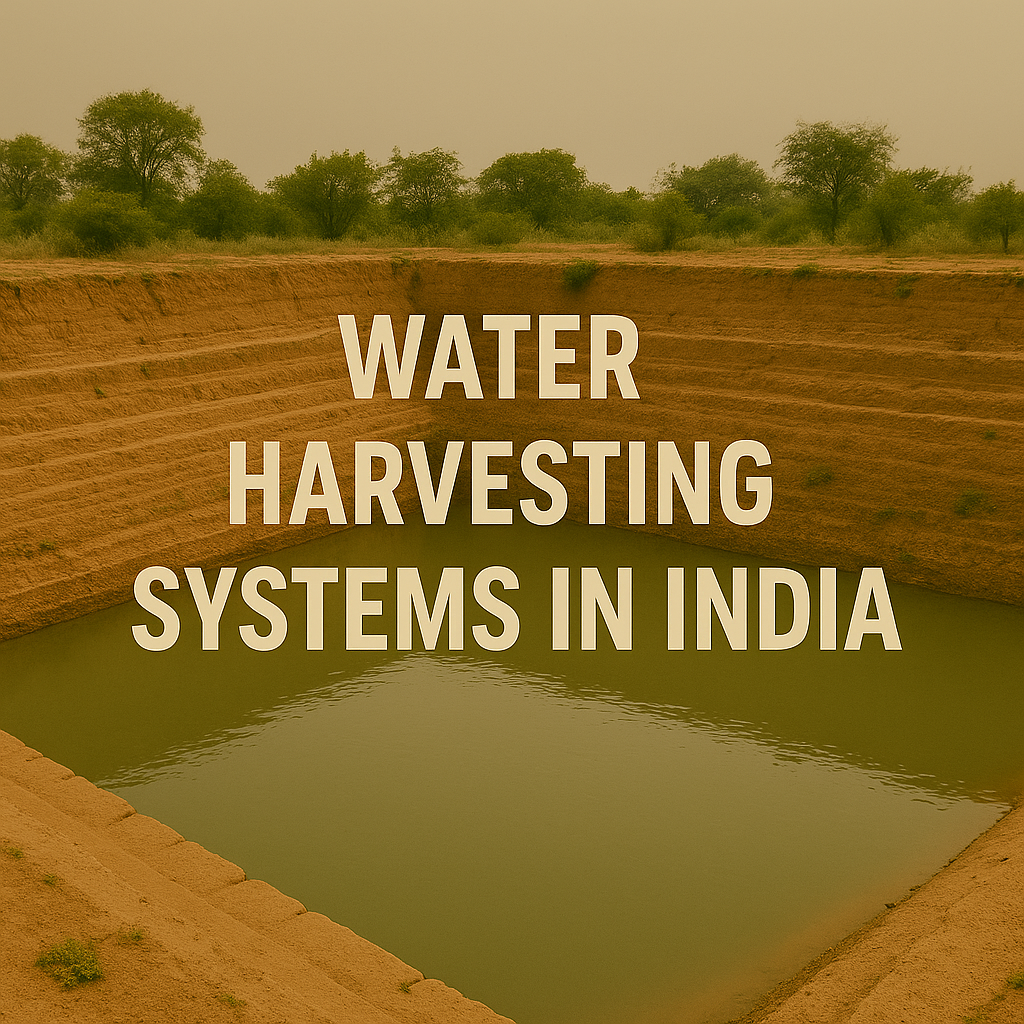Solutions for a Water-Secure Future
Introduction
One of the most effective and sustainable solutions emerging in India is water harvesting systems. These systems involve the collection and storage of rainwater for future use, helping to conserve water, reduce dependence on traditional sources, and recharge groundwater levels. Given the country’s diverse geography and climatic conditions, water harvesting has the potential to solve a multitude of water-related problems, from irrigation to drinking water supply.India, despite receiving significant annual rainfall, faces an ongoing water crisis exacerbated by rapid urbanization, population growth, and climate change.
Why Water Harvesting is Crucial in India
1. Growing Water Scarcity
India is home to over 1.3 billion people, and yet it is one of the world’s most water-stressed countries. Groundwater levels are depleting rapidly due to over-extraction for agriculture and domestic use. The situation is worsened by an inefficient water distribution system and poor management of existing resources.
2. Replenishing Groundwater Tables
With the depletion of groundwater, traditional sources like wells, rivers, and lakes are drying up. Rainwater harvesting helps replenish the groundwater table by channeling water into recharge system, which gradually seep into underground aquifers. This process plays a vital role in maintaining sustainable water resources.
3. Environmental Impact
Harvesting rainwater reduces surface runoff, which can lead to soil erosion and waterlogging. Additionally, it helps prevent flooding in urban areas, reducing the strain on drainage systems and urban infrastructure. The practice is a sustainable way to manage water resources, which is increasingly important as we face the impacts of climate change.
Different Methods of water Harvesting Systems in India
- Rooftop water Harvesting (RRWH)
The most common method in urban and suburban areas, RRWH involves capturing rainwater from rooftops through pipes, filters, and gutters, and directing it into storage tanks or recharge sysytem. This water can be used for domestic purposes such as drinking, cooking, and irrigation after proper filtration. - Surface Runoff Harvesting
This method involves collecting rainwater that flows across paved or impervious surfaces, such as roads and parking lots. The water is collected in channels or reservoirs and can be used for irrigation, industrial use, or groundwater recharge. - Check Dams and Percolation
In rural areas, check dams and percolation are constructed to collect water from seasonal streams and floods. This method is most effective for replenishing groundwater levels in areas with high rainfall. - Subsurface Water Harvesting
This method involves collecting rainwater that infiltrates the soil naturally and storing it in underground cisterns or aquifers. It’s an ideal solution for areas with permeable soil. - Water Storage Tanks and Wells
These are large containers or underground structures where rainwater is stored for future use. Stored water can be utilized for irrigation, cleaning, and even potable water needs, depending on filtration systems.
Advantages of Water Harvesting Systems in India
1. Reduces Dependence on Groundwater
water harvesting helps reduce the excessive withdrawal of groundwater, which is the primary source of water in many parts of India. By harvesting rainwater, households, businesses, and industries can depend less on groundwater sources, ensuring long-term sustainability.
2. Low-Cost Solution
One of the major advantages of rainwater harvesting is its affordability. The cost of installation is low, especially in comparison to the infrastructure required for urban water supply systems. It also requires minimal maintenance, making it a cost-effective solution for both rural and urban households.
3. Increased Water Availability
By capturing rainwater during the monsoon season, areas that face water shortages during the dry months can stockpile a significant amount of water. This stored water can be used for drinking, agricultural irrigation, or industrial purposes, ensuring year-round water availability.
4. Prevention of Soil Erosion and Flooding
Rainwater harvesting reduces runoff and prevents soil erosion, which can degrade the land and reduce agricultural productivity. By slowing down the flow of rainwater, we help in preventing flooding in cities and agricultural areas, reducing damage to property and crops.
5. Improved Water Quality
water is naturally pure, containing fewer contaminants compared to surface water from rivers or lakes. With the right filtration and storage systems, harvested rainwater can be a cleaner, safer source of drinking water, reducing the risk of waterborne diseases.
Government Initiatives for Water Harvesting Systems in India
India’s government has recognized the importance of water harvesting in addressing the water crisis and has introduced several initiatives to promote the practice:
- Jal Shakti Abhiyan: A nationwide campaign that focuses on water conservation and rainwater harvesting through the active participation of citizens and communities.
- National Mission for Clean Ganga : Focuses on the restoration and preservation of the Ganges River, including the promotion of rainwater harvesting and wastewater management.
- State Policies: States like Tamil Nadu, Rajasthan, and Maharashtra have made it mandatory to install rainwater harvesting systems in residential and commercial buildings.
How to Get Started with water Harvesting system in india
Implementing a rainwater harvesting system is easier than you think. Here’s how you can get started:
- Assess Your Needs: Determine the amount of water you need based on your household or business requirements.
- Choose a Suitable System: Depending on your location, space, and budget, choose between rooftop rainwater harvesting, surface runoff harvesting, or underground storage.
- Installation: Hire a professional to install the system, ensuring proper filtration and storage facilities.
- Maintenance: Regularly clean gutters, filters, and tanks to maintain water quality.
Conclusion:
Water scarcity is one of India’s most pressing challenges. Rainwater harvesting is a simple yet effective solution that can significantly mitigate this issue. By adopting rainwater harvesting, we can contribute to groundwater recharge, reduce water wastage, and ensure a more sustainable future.
At The Ground Water Company, we provide cutting-edge solutions for groundwater management and rainwater harvesting. approach helps businesses, households, and communities achieve sustainable water management, optimize water use, and ensure long-term water security.


